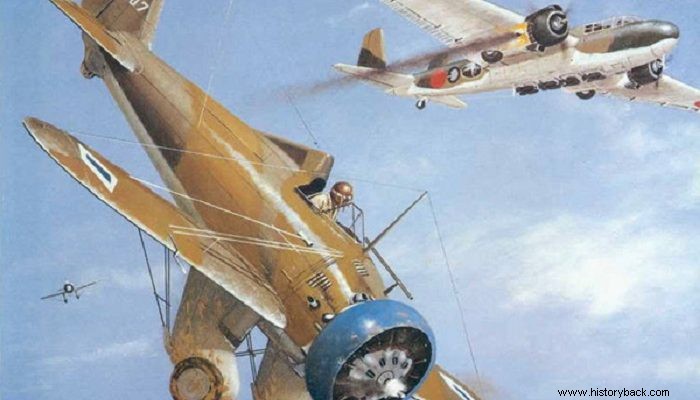
The Boeing P-26 Peashooter was the first monoplane, all-metal American fighter to enter service with fighter squadrons. Design began in 1931 as the Model 248. The prototype first flew in 1932. The first production model was the P-26A. Two single P-26Bs with Pratt &Whitney R-1340-33 engines followed, followed by the P-26C with a carburettor and other modifications.
The aircraft had an open cockpit and fixed landing gear but was soon obsolete. Nevertheless, he fought before and at the beginning of World War II. Pre-war, the P-26 equipped at least 25 squadrons of the US Air Force. However he first saw action with the Chinese national emblems . China procured 11 P-26Cs which joined the 17th Squadron of the 3rd Pursuit Squadron.
On 15 August 1937 8 P-26s took off to intercept 28 Japanese Mitsubishi G3M Nell bombers. The dogfight was particularly tough for the far fewer Chinese pilots who also lacked training and lacked state-of-the-art aircraft. Nevertheless the Chinese P-26s shot down 3 bombers without any casualties of their own.
The P-26s were up against the latest Japanese naval Mitsubishi A5M fighter jets, which were faster and much more maneuverable, but also extremely "sensitive" to fire. P-26s were also flown by Chinese aces John "Buffalo" Huang (8 kills and one common) and John Wong Panyang (13 kills) who successfully faced the A5Ms until all P-26s were destroyed in combat and replaced in the first instance by Gloster Gladiators.
An aircraft was procured by the Spanish Democratic Air Force for evaluation but the aircraft was shot down early in the Civil War. With American flags, nine US P-26s guarding the Panama Canal operated - without encountering an opponent.
The P-26 saw action in the early stages of the Pacific War. On the day of the Japanese attack on Pearl Harbor the Filipinos had 28 P-26s in the Philippines of which only 12 were operationally assigned to the 6th Pursuit Squadron of the Philippine Air Force. Under Captain Jesus Villamor the P-26s faced the Japanese Mitsubishi A6 Zero.
Filipino pilots claimed the downing of four Japanese aircraft (3 Zero, one G3M), two of which were shot down by Villamor himself. However, the success was short-lived. Soon the skies were filled with modern aircraft with the Rising Sun insignia, and the P-26s were out of luck. The latter were destroyed from the ground by their pilots to prevent them from being overrun by the Japanese.
In 1942 Guatemala purchased seven P-26s which remained in service until 1956 and even saw action in 1954 during a military coup in the country. It is worth noting that the P-26 was the last Boeing fighter to enter service until the appearance of the F/A-18 Super Hornet in 2002.
TECHNICAL CHARACTERISTICS
Type:Single-engine, single-seat fighter
Length:7.19 m
Spread:8.5 m
Height:3 m
Wing area:23 square meters
Weight empty/full:996/1,224 kg
Engine:Pratt &Whitney R-1340-27 Wasp, 9-cylinder, 600 HP, two-blade fixed-pitch propeller
Top speed:377 kilometers per hour
Operational range:560 km
Rate of climb:719 feet per second
Armament:2 x 7.62mm machine guns or one of 7.62 and one of 12.7 mm. 2 30 kg bombs, or 5 14 kg anti-personnel bombs.


